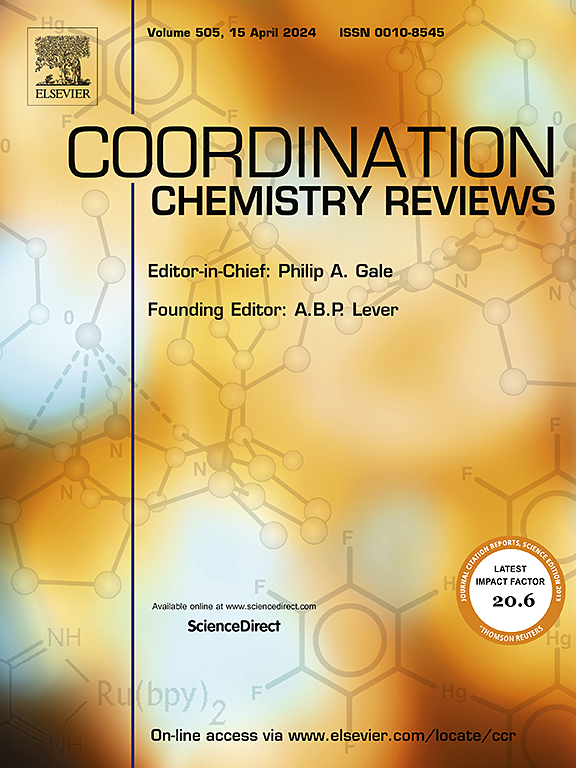解锁双电子ORR: mof和COFs在机理洞察和性能优化中的协同作用
IF 23.5
1区 化学
Q1 CHEMISTRY, INORGANIC & NUCLEAR
引用次数: 0
摘要
电催化双电子氧还原反应(ORR)作为传统蒽醌法生产过氧化氢(H₂O₂)的潜在储备引起了相当大的兴趣。推进这种方法需要开发高度优化的电催化剂,具有卓越的活性、特异性、选择性和H₂O₂产率。金属有机框架(mof)和共价有机框架(COFs)体现了一类创新的晶体多孔材料,其特点是高比表面积、结构可调性和均匀分布、明确的金属位点。这些特性使mof和COFs成为高性能电催化的优秀候选者。在这篇综述中,我们介绍了最近在设计MOF和cof为基础的2 - orr电催化剂生产H₂O₂的进展。本文首先介绍了电催化机理和评价其性能的方法,然后总结了基于MOF和cof的2e-ORR电催化剂,并讨论了结构-性能关系。最后,我们提供了进一步推进这一新兴领域的潜在方法的见解。本文章由计算机程序翻译,如有差异,请以英文原文为准。
Unlocking the two electron ORR: Synergistic roles of MOFs and COFs in mechanistic insights and performance optimization
The electrocatalytic two-electron oxygen reduction reaction(ORR) has attracted considerable interest as a potential reserve to the traditional anthraquinone method for producing hydrogen peroxide (H₂O₂). Advancing this approach requires the development of highly optimized electrocatalysts with superior activity, specificity, selectivity and H₂O₂ production rates. Metal–organic frameworks (MOFs) and covalent organic frameworks (COFs) embodies an innovative category of crystalline porous materials characterized by high specific surface areas, structural tunability, and uniformly distributed, well-defined metal sites. These attributes make MOFs and COFs excellent candidates for high-performance electrocatalysis. Within this review, we present recent progress in designing MOF and COF-based 2e-ORR electrocatalysts for H₂O₂ production. We begin by introducing the electrocatalytic mechanism and the methods used to evaluate the performance of the 2e-ORR, followed by a summary of MOF and COF-based 2e-ORR electrocatalysts, discussing structure–property relationships. Finally, we offer insights into potential approaches for advancing this emerging field further.
求助全文
通过发布文献求助,成功后即可免费获取论文全文。
去求助
来源期刊

Coordination Chemistry Reviews
化学-无机化学与核化学
CiteScore
34.30
自引率
5.30%
发文量
457
审稿时长
54 days
期刊介绍:
Coordination Chemistry Reviews offers rapid publication of review articles on current and significant topics in coordination chemistry, encompassing organometallic, supramolecular, theoretical, and bioinorganic chemistry. It also covers catalysis, materials chemistry, and metal-organic frameworks from a coordination chemistry perspective. Reviews summarize recent developments or discuss specific techniques, welcoming contributions from both established and emerging researchers.
The journal releases special issues on timely subjects, including those featuring contributions from specific regions or conferences. Occasional full-length book articles are also featured. Additionally, special volumes cover annual reviews of main group chemistry, transition metal group chemistry, and organometallic chemistry. These comprehensive reviews are vital resources for those engaged in coordination chemistry, further establishing Coordination Chemistry Reviews as a hub for insightful surveys in inorganic and physical inorganic chemistry.
 求助内容:
求助内容: 应助结果提醒方式:
应助结果提醒方式:


